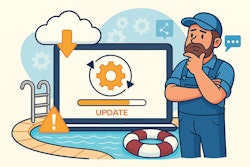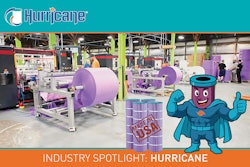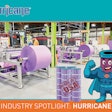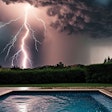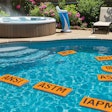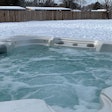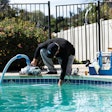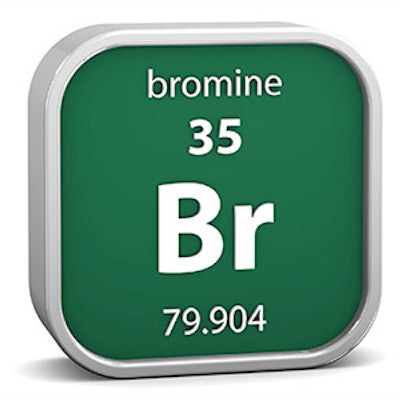
For the past 20 years or so, saltwater chlorine generation has been one of the industry's hottest topics. Developed originally in Australia, the technology caught on like wildfire in the last decade and remains a bestselling component of the pool system.
During much of that time, another similar technology, bromine generation, has found its way into thousands of portable spas but has received almost no attention at all.
Despite its relative anonymity, proponents of the technology point to a number of benefits they argue make bromine generation a great choice for treating hot water environments. Critics of the technology point to reservations commonly attached to salt chlorine generators, as well as concerns over disinfection byproducts, chiefly bromates.
When looking objectively at the technology, it is clear that there are indeed big upsides worth considering, but like any treatment method, bromine generation comes with its own set of necessarily calibrated expectations.
GENERATING THE BENEFITS
Bromine generation is now available from a variety of portable spa manufacturers, for a variety of reasons. In many respects, those benefits are very similar to chlorine generation.
The two technologies are also very comparable and familiar to industry pros. In both cases, salt is dissolved in the water, and then the water runs through a chamber that contains electrodes, which deliver a low electrical current that produces the active sanitizer — chlorine in one case, bromine in the other.
It's worth noting that bromine salt concentration is maintained at 1300 to 1500 ppm, far less than the (sodium chloride) salt concentration required for chlorine generation, which is usually in the 3000 to 5000 ppm range.
As is the case with SCGs, using a bromine generator means there is no need to purchase bromine compounds, transport them, store them and add them to water.
For spa users, that means they can skip the bromine tab floater — which is especially nice for spa users who might otherwise remove the floater when using the spa and forget to replace it when done, only learning their mistake when returning later to find a nasty, un-sanitized stew. With a bromine generator, this is completely avoided, as it's always there to deliver bromine sanitizer as needed.
One of the issues inhibiting the proliferation of the technology has been the service life of the electrode. Bromine has an atomic weight twice that of chlorine, and as such can be extraordinarily rough on electrodes. As a potential weak spot in the system, manufacturers promote their individual electrode designs, with some touting their all-carbon based electrodes as a more effective alternative to titanium- coated electrodes.
Because of this difference in the effect on electrodes, bromine salt should not be run through a system designed for chlorine generation.
THE DEALER PERSPECTIVE
For dealers that sell spas, bromine generation systems have given them new ways to talk with their customers about water chemistry and water quality overall. In particular, the feel of the water is an appealing benefit to customers.
Micah Perfetto, co-owner of Whiteswan Pools & Spas (Chino, Calif.), a company that actively promotes units that include bromine generation, first came to appreciate the benefits as a result of doctor's recommendation, a scenario that remains central to how he describes the concept.
"When my daughter was three years old, she had eczema, and her doctor encouraged us to take her to the beach because the saltwater would help," he recalls. "He was right, it did make a difference, but we wanted to be able to have saltwater available on a daily basis. At first we tried a saltwater chlorination system in our spa, but had a number of issues. We switched to the sodium bromide and bromine generation and have been using it in our family ever since and enjoy the way it makes our skin feel. That was 16 years ago and now we make a point of making the systems available to our customers. It's definitely part of our sales pitch."
Perfetto reports that his customers appreciate the treatment method because they "don't feel like they're sitting in a chemical bath," he says. "Obviously it's treated water, but it really doesn't feel that way."
In addition to the sensory benefits, Perfetto and other proponents of the technology tout the savings on chemicals and overall reduced, but not eliminated, maintenance burden.
"We have a display in our store where we stack up all the different types of chemicals you need on an average spa over a year's time. There's probably a dozen or so products sitting there. Some customers tell us when they see the display that they feel like they'd have to be a chemist just to take care of their spas," Perfetto says.
Another maintenance-related perk is the reduced need to drain and refill spas on a regular basis, due largely to the fact that bromine generation does not rapidly increase TDS buildup. "If the system saves three drain-and-refills during the year, that's about a $150 a year here in southern California," Perfetto says. "And in an area where drought and water conservation are big concerns, avoiding draining because you're not building up TDS is a huge benefit."
SYSTEM EXPECTATIONS
Like saltwater chlorine generation, Perfetto finds the biggest peril with bromine generation comes down to overselling the concept as either maintenance-free or chemical free.
"There are some salespeople who will tell customers it's some kind of magic elixir that eliminates any need for regular maintenance," he says. "We make a big point of teaching our customers about the importance of maintaining balance pH and alkalinity, for example. The only time we have unhappy customers is when they come to us after having been given unrealistic expectations by an overzealous sales person somewhere.
"We found so long as they have a realistic expectation for the benefits and what they need to do to maintain their spas, they're almost always extremely happy!"
The above discussion was prepared with assistance from Robert W. Lowry, Paul Birkbeck, a long-time proponent and inventor of alternative treatment technologies, and Michael Manning of Blue Water Technologies, an OEM manufacturer of bromine generation systems.


























